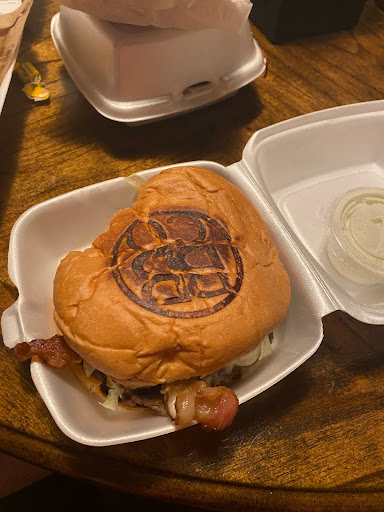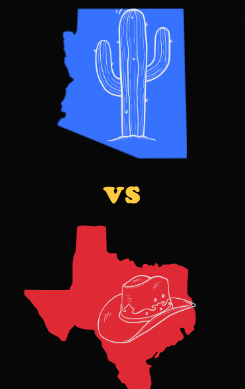Double the Trouble
The downsides of getting an associate degree in high school
Photo by Ezra Baze
Students a part of the Midlothian Collegiate Scholars Academy get the opportunity to graduate with two degrees; a high school diploma and an associate’s degree from Navarro. However, there are many flaws in the program that cause complications for the members. – Made in Canva
Many students dream of the moment they graduate high school. Walking across the stage, shaking hands with the principal, and receiving the piece of paper they had worked toward for four years. However, for a select few students in Midlothian ISD, their high school diploma won’t be the only one they’ll be handed that year. The Midlothian Collegiate Scholars Academy allows students to simultaneously receive an associate degree and high school diploma through a highly specific dual credit degree plan. As a senior who’s nearly been through the entire process, I can tell you confidently that receiving my associate at 17 might be one of my biggest academic regrets. There are numerous flaws within this program, but here are my six reasons why I would advise against joining.
- Membership begins at a time when knowledge about major college decisions is limited
To be a part of Midlothian Collegiate Scholars Academy, also known as MCSA, students must agree to join in the spring semester of their eighth or ninth grade year. This means that the student is anywhere from 13 to 15 years old at the time of applying. Personally, when I applied, I was 13 and knew just about nothing concerning college or how to pay for it. MCSA was advertised through presentations as a wise financial decision for incoming freshmen, as dual credit is much cheaper than regular college classes, which was why I joined. What they failed to promote, however, was the stress, anxiety, and eventual financial consequences of participating in the program. But since students are so young when they join, MCSA can impress upon them all of the “pros” that come with being part of an advanced program and leave out the realities that come with being a college student and graduating at such a young age. By labeling it as a smart financial choice, they are able to loop the parents in as well.
- Finding resources for the program is next to impossible
If you’ve never heard of the Midlothian Collegiate Scholars Academy, I assure you, you’re not alone. The program stopped advertising in 2020, so finding information about them is difficult. Because they stopped promoting the program after my first year, finding the heavily detailed course plan was next to impossible. This left my peers and I unsure if the classes we were registering for aligned with the program. Only after days of deep diving into the backlinks of MISD’s website was I able to find the original course list for MCSA. For students in my class, the lack of promotion after we began the program almost cost us thousands of dollars in useless, unaligned courses.
- Coursework doesn’t always align with personal interests
Because of this highly specified course plan, my schedule became filled with courses I had no interest in. High school is an excellent opportunity for students to explore their interests through electives and sports to guide them down potential career paths or give them ideas of what to study in college. The students in MCSA, though, do not get to choose their dual credit classes and must take the ones assigned by the program to align with Navarro College’s degree plan. Because I was too busy taking theater production, speech, and British literature classes, I was left with no room for electives to explore my interests. It wasn’t until this year, when my schedule finally opened up, that I was allowed to take courses I was genuinely curious about. Unfortunately, by this point, it was too late as college application season had begun and I was supposed to have a solid idea of what I plan to study in my post-secondary education.
- Anxiety is magnified when choosing a major
Entering the college application season is stressful for an average high school senior, but the stress is magnified for a student joining the high pressure, new college environment without room for error. Junior year of college is when many students begin their major-specific coursework, leaving the first two years of college a time to complete introductory courses, explore their options, and even change majors. At the Univerity of Texas at Austin, it is estimated that about 65% of students change their major at least once. For other schools, this percentage is higher, usually with students changing in their first two years. However, for MCSA members, the two-year padding is removed, and at 18 years old students must have their major locked down and begin these major-specific courses. When I started college applications, choosing a major was difficult as I was filled with the pressure of entering college as a junior. Room for mistakes is limited, adding to college application season’s overwhelming anxiety.
- The complexity of credit transfering
Depending on the college of choice, credit transfer is a complicated process. For in-state students, dual credit is relatively simple to transfer if you know the ropes of credit cross-checking. However, for out-of-state students, the complexity of credit transferring becomes evident. For example, I was required to take a semester of Texas government as it was a graduation requirement for Navarro College. If I chose to attend a univeristy outside of Texas, though, that credit would not be required because it is state-specific. While this applies to Texas government, this is not the only example. This layer is added when deciding on a college and choosing one that accepts a majority of the credits received through MCSA.
- The financial consequences
Not only do my credits become confusing when filling out applications, but first-year college students entering with 60 dual credit hours aren’t typical for many universities. Many schools don’t know if I would be considered a transfer student or incoming freshman, complicating financial aid opportunities. I originally joined MCSA because it was advertised as a program that would end up saving me thousands of dollars, but now the program could potentially hurt my chances of receiving financial aid and grants on an annual basis, which is detrimental to a student like me who will be financing my post-secondary education on my dime. Even some higher paying financial aid and scholarship programs are on a 120 hour timeline, and since MCSA members have 60 hours already, leaving students to complete their degree in two years with no wiggle room unless they want to drop the dollar for it.
The Midlothian Collegiate Scholars Academy allows students to graduate with two degrees, and while this opportunity is rare and a seemingly intelligent financial decision, the consequences for the student involved outweigh the pros.












